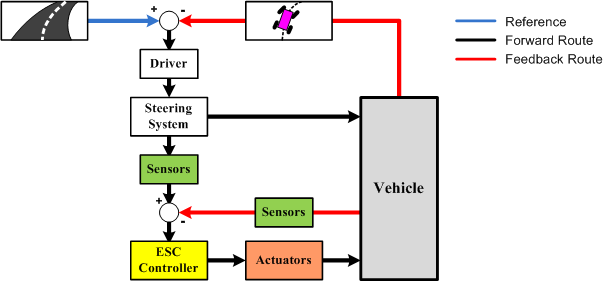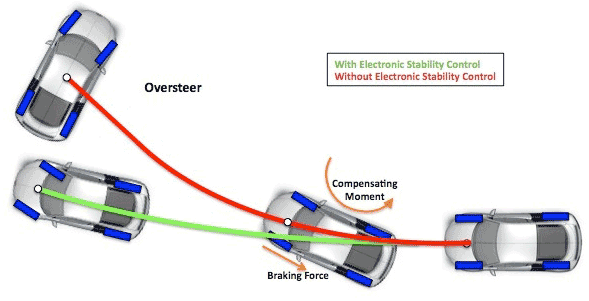Electronic Stability Control
- Basic Description
-
Electronic Stability Control (ESC), also called Vehicle Dynamic Control (VDC), Dynamic Stability Control (DSC), Electronic Stability Program (ESP), Vehicle Stability Control (VSC) or Vehicle Stability Assist (VSA), is one of the most significant active safety systems in modern automobiles. The main function of this system is to improve the handling performance of the vehicle and prevent possible accidents during severe driving maneuvers (e.g. fast cornering or lane changing with emergency braking). Generally, these systems stabilize the vehicle by applying the necessary yaw moment (generated by individual braking force on each wheel) and regulating the side slip angle of the vehicle based on a comparison between the vehicle state and the driver's demand. Some ESC systems also reduce the power from the engine during excessive steering.
In a very hard turn, especially on a slippery road, a vehicle may "fishtail" or point itself in a direction different from the one intended by the driver. This condition is referred to as understeer or oversteer. In an oversteer situation, the vehicle turns more than the driver intended because the rear end loses traction and slides out. Understeer occurs when the front wheels lose traction and the vehicle turns less than the driver intended.

The figure above shows the architecture of a typical stability control system, incorporating three fundamental elements: the driver, the vehicle and the environment. The ESC system uses the steering angle and vehicle speed to calculate the intended path of the vehicle. Using a yaw rate sensor in combination with a lateral acceleration sensor, the system calculates the actual path of the vehicle. In the normal control loop, the driver detects the deviation of the vehicle from the current road trajectory and corrects it through the steering system. When the driver is about to lose control of the vehicle, the electronic stability control system senses the deviation between the intended path of the vehicle and the actual path of the vehicle. The ESC system generates the necessary yaw moment by automatically actuating a braking force on the correct wheel to pull the vehicle back to the intended path.


The United States Insurance Institute for Highway Safety (IIHS) issued the results of a study in May 2010 concluding ESC reduced the risk of fatal crash involvement by 33% (49% for single-vehicle crashes) [1]. A 2011 study by the National Highway Traffic Safety Administration (NHTSA) concluded that ESC reduced fatal first-event rollovers by 56 percent and fatal impacts with fixed objects by 47% in passenger cars [2]. Since the 2012 model year, all cars and light trucks sold in the U.S. have been required to have an electronic stability control system.
- Sensors
- Steering wheel position sensor, yaw rate sensor, lateral acceleration sensor, wheel speed sensor
- Actuators
- brakes, throttle
- Data Communications
- High-speed CAN or FlexRay bus.
- Manufacturers
-
Bendix,
Bosch, BWI Group, Continental, Johnson Electric, Mitsubishi Electric, Nissin, TRW, Wabco
- For More Information
- [1]
Effects of Electronic Stability Control on Fatal Crash Risk, C. M. Farmer, Insurance Institute for Highway Safety, May 2010.
- [2]
Crash Prevention Effectiveness of Light-Vehicle Electronic Stability Control..., DOT HS-811-486. U.S. Department of Transportation.
- [3]
Electronic Stability Control, Wikipedia.
- [4] Electronic Stability Control, safercar.gov.
- [5]
Simulated Comparison between Vehicles With and
Without ESC Systems (video), CVEL video. [wmv format]
- [6] Braking and Stability Control, Freescale website.
- [7] Electronic Stability Control (ESC) Revealed, YouTube, Dec. 28, 2010.
- [8] Q&A: Electronic Stability Control, Insurance Institute for Highway Safety, May 2011.
- [9] Electronic Stability Control, YouTube, May 24, 2012.
- [10] Electronic Stability Control, Cars.com, July 20, 2012.
- [11] 2015 Chrysler 300 | Electronic Stability Control, YouTube, Jan. 9, 2015.
|

